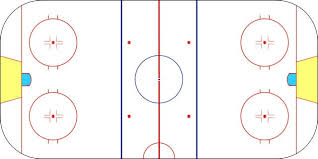In this dynamic era of ice hockey, the trapezoid means a revolutionary force, importantly changing the goalkeeper’s tactics and team dynamics.
This distinctive shaded region behind the goalkeeper’s net is more than just an ice maker; it changes the way the game is being played.
This comprehensive analysis uncovers the NHL trapezoid rule and attempts to simplify its difficulties so that readers of all groups and ages can relish and understand it conveniently.
This rule has changed the sport of hockey like never before by using this regulation as a lens to see how it has affected each amazing event.
What is The Trapezoid Rule in Hockey?
One of the most valuable and key elements of ice hockey is the hockey trapezoid, or NHL trapezoid regulation, which mostly controls the goalkeeper’s movements.
It is the clear green-colored region behind the goal line and the goalkeeper’s net that acts as an important boundary.
The goalkeeper is free to play the puck inside this trapezoid without drawing a penalty. But if the goalkeeper goes outside the trapezoid and past the final red line, which is called the goal line, they will be penalized for two minutes.
Why Did the Hockey Trapzoid Come into Existence?
A major and significant alteration in the changing of the game led directly to the emergence of the trapezoid in ice hockey.
In the 1980s, the great Hockey game was referred to as high-scoring games, with professional players like Mario Lemieux and Wayne Gretzky setting scoring records.
The talent pool did, however, become more diluted as the league grew in the 1990s, and the teams began to utilize a defensive strategy called the neutral zone trap.
Teams that played the neutral zone trap put defense above all else, waited for the opposite team to make a mistake, and took benefit of mistakes.
As a result, there was a sharp decline in the scoring, with goals per game falling by 30-40%. The so-called “dead puck era,” which peaked in the late 1990s and early 2000s.
How to Address the Dead Puck Era?
A rules committee was introduced to boost offensive gameplay in reaction to the 2004–2005 NHL lockout and the sport’s waning passion.
One game-changing innovation that stood out among the many regulation transformations used to encourage scoring was the introduction of trapezoid hockey behind the net.
How Does the NHL Trapezoid Rule Enhance Offence?
NHL goalkeepers have gotten good at playing the puck outside of their crease before the NHL Trapezoid Rule was implemented.
This proficiency enabled them to retrieve the puck and pass it to their defense, thus stopping the opposite team from gaining possession in the offensive zone.
Shooting the puck into the offensive zone by guiding it into the corner or around the boards is a popular offensive trick.
By using this tactic, the attacking player can outmaneuver the opposition or force mistakes. But as the goalkeeper became more adept at recovering pucks, this tactic lost its effectiveness.
Consequently, the only option available to offensive teams was to carry the puck past the blue line. But this wasn’t an easy task, as the defensive players could stack the blue line, making it difficult for teams to enter the offensive zone.
How to Break the Trap with the Trapezoid Rule?
The alteration of the game was modified by the addition of the trapezoid. It made it more challenging for the goalkeeper to help their defense rapidly clear the puck by limiting their ability to play the puck to the given precise spot.
This uplifts the offensive team’s chances of regaining possession by allowing them to fire the puck into regions that the goalkeeper could not easily access.
Due to this change, the offensive team had a higher chance of taking possession, and forechecking became more efficient.
What is The Martin Brodeur Rule?
The trapezoid rule is frequently referred to as “The Brodeur Rule” in honor of the most prominent goalkeeper Martin Brodeur.
Brodeur has won the Stanley Cup championship and was inducted into the ice hockey hall of Frame when he was playing for the New Jersey Devils during the trap era.
The Devils were famous for their skill at using the neutral zone trap, and Brodeur was regarded as one of the greatest goalkeepers in the League.
What is The Impact of the Trapezoid Rule on Scoring?
The rule modifications implemented following the 2004-2005 lockout season have gotten bigger scoring, even though it is quite challenging to point out the precise impact of the trapezoid rule on scoring.
Hockey has become more thrilling as a result of the NHL’s constant rule alteration to rapidly play and counter the neutral zone trap.
What Are The Arguments Against the Trapezoid Rule?
Along with the positive impact on the game, the trapezoid has some critical arguments as well from various quarters. Here are the main arguments against it:
- Rise in Accidents: The goalkeeper’s capability to help defensemen is restricted by the trapezoid rule, which could result in more hits and injuries.
- Stickhandling Goaltenders Are Weak: When goalkeepers participate in offensive plays that aren’t well-suited for them, they might become unpredictable and make mistakes.
- Dump and Chase Hockey: Instead of depending solely on inventive passing plays, the trapezoid pushes teams to shoot the puck into the corners and fight for possession.
- Perplexing to Fans: It can be more challenging for casual or inexperienced fans to grasp the game when there are more lines on the ice.
Even though some of these points have merit, it is important to take the bigger picture into account. The neutral zone trap’s efficiency is countered by the trapezoid rule, making the game more thrilling and offensive.
In the universe of ice hockey, the trapezoid has become a major revolutionary change. It controls goalkeeper movements and affects the dynamic of both defensive and offensive strategies.
Despite its critics, the trapezoid has positively affected hockey, bringing in a new era of exhilarating offensive gameplay and cerebral playing.
When was The Trapezoid Put in Hockey?
In an attempt to elevate boost scoring possibilities, the NHL instituted the Trapezoid rule, sometimes referred to as the goalkeeper trapezoid, for 2005-2006.
Goalies are only permitted to play the puck inside the trapezoid under this regulation, and breaking it carries consequences.
This regulation transformation was intended to discourage goalkeepers from functioning as a third party and to promote offensive play by restricting their capability to slow down play.
Read More: What is the Icing Rule in Hockey?
FAQs
What is the history of the hockey term “trapezoid rule”?
Because of the trapezoidal shape that hockey makes on the ice, two parallel lines, and two slanted sides, the hockey trapezoid rule, also known as the trapezoid rule, was developed.
Could you describe the rationale behind the hockey trapezoid rule?
The goal of the trapezoid rule in hockey is to level the playing field, increase scoring opportunities, and excite fans by limiting goaltenders’ ability to handle the ball behind the net during the 2005–2006 campaign.
What effects does the trapezoid rule have on hockey play?
The hockey trapezoid regulation prevents goalies from freely handling the puck behind the goal line, which modifies the game’s dynamics. This encourages defensemen to move the puck more quickly and cuts down on the amount of time goalies need to set up plays.
Does hockey have any exceptions to the trapezoid rule?
Indeed, there is a significant exception to the trapezoid distribution. The trapezoid rule does not apply when a goaltender delivers the puck to a teammate and that player moves the puck up the ice right away. This exception encourages quick changes from defense to attack.
Do all hockey leagues use the trapezoid rule as normal practice?
No, the trapezoid rule is not applied in every hockey league. It is mostly used in professional settings, most notably in the NHL. Different leagues may have different policies regarding goaltender puck handling, or they may not have any policies at all.


